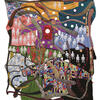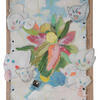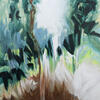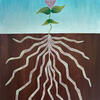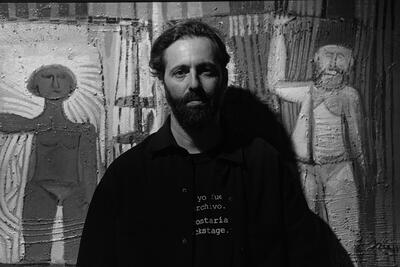Curator Juan Canela
The NEXT Section 2025 calls on galleries that venture into creation and experimentation, questioning their own models and reinventing the ways they accompany their artists while weaving new conversations with their audiences.
In this edition, four artist–gallery duos intertwine their voices to open shared territories. From diverse geographies and generations, their dialogues traverse landscape and territory, identity and language, the spiritual and the invisible.
Across multiple languages and gestures, these correspondences invite us on a journey through some of the essential questions resonating today in the art of Latin America and the Caribbean: How do we inhabit? How do we name? How do we imagine what connects us?
__
The dialogue between Gabriela Esplá (Panama City, 1990) and Alice Ricci (São Paulo, 1985) unfolds from the idea of landscape to interrogate territory. In her most recent paintings and collages, Esplá deploys a pictorial gesture and a vibrant stroke where movement and color become witnesses to a story: how the construction of the Panama Canal erased entire towns along with their social and cultural memories. Ricci, in contrast, turns inward to the spaces she inhabits. In her works, lines and planes of color overlap until forming an abstract stillness, an imaginary map where multiple landscapes condense into a single image—a geography between fiction and cartography.
The works of Laura Castro (Santo Domingo, 1982) and Cecilia Ordóñez (Pamplona, Colombia, 1949) also engage in a dialogue around landscape, delving into our intimate relationship with nature. In Castro’s delicate paintings and collages, the landscape fragments, decomposes, and recomposes itself, challenging habitual ways of seeing and emerging as a tool for rootedness and political imagination. Ordóñez’s ceramics, in turn, condense the memory of gesture and the plasticity of fired earth. Her forms evoke the archaic, the primary, the essential. Together, the two artists craft a conversation of strokes and materials that whisper the importance of the fundamental—of that which endures.
Andrea Santos (Panama City, 1991) and Blanca Machuca (Tucumán, Argentina, 1959) delve into the depths of being to embrace a world where the oneiric, the ritual, and the magical intertwine. Santos’s intuitive paintings and Machuca’s suggestive textiles become thresholds to a spirituality that dissolves boundaries between the human and the non-human, inviting us to let intuition guide our gaze and imagination.
In the practices of Abigail Reyes (El Salvador, 1984) and Marco Aviña (Mexico City, 1986), the intimate and the public, the personal and the social, weave together through a sensitivity to popular culture. Reyes works with the word—between photography and textile—to play with the messages inhabiting walls and fabrics, transforming the everyday into poetry.
Aviña, in a series of handmade paintings that verge on collage, appropriates popular icons and symbols and merges them with images and sensations drawn from his dreams, composing colorful, vital works where the popular also becomes a territory of desire.
Galería Mateo Sariel, Panama City, Panama
Gabriela Esplá
CRUDO, Rosario and Buenos Aires, Argentina
Alice Ricci (São Paulo, 1985)
Ala Projects, New York, United States
Laura Castro (Santo Domingo, 1982)
Salón Comunal, Bogotá, Colombia
Cecilia Ordóñez (Pamplona, Colombia, 1949)
Galería Arteconsult, Panama City, Panama
Andrea Santos (Panama City, 1991)
Ceibo Gallery Miami, United States
Blanca Machuca (Tucumán, Argentina, 1959)
Galería Matia Borgonovo, El Salvador
Abigail Reyes (El Salvador, 1984)
Encarte Galería, Mexico City, Mexico
Marco Aviña (Mexico City, 1986)
Juan Canela (Spain, 1980)
He is the Chief Curator of the Museum of Contemporary Art of Panama and a member of the Advisory Committee of the Cader Institute of Central American Art at the Reina Sofía Museum. Recently, he has curated the Projects section at Artbo Bogotá (2024), co-curated the 23rd Paiz Art Biennial in Guatemala (2023), and curated El Patio ABC in Baja California, Mexico (2023–2024).
Previously, he served as the Artistic Director of ZsONAMACO in Mexico City (2020–2023); Associate Curator at the Center for Artistic Residencies at Matadero Madrid (2020–2021); and Research and Symposium Associate for the osloBIENNALEN FIRST EDITION (2019–2020).
He was the co-founder and co-director of the BAR project residency program in Barcelona (2012–2020) and was a member of the program committee at HANGAR Barcelona (2016–2019). He has curated projects in museums, galleries, and institutions such as MAMM Museum of Modern Art of Medellín; Fundación JUMEX, Mexico City; CA2M Centro de Arte Dos de Mayo, Móstoles; TBA-21 Madrid; CRAC Alsace, France; Artissima, Turin, Italy; Centro Cultural de España and Casa Quien, Dominican Republic; Tabakalera, San Sebastián; SOMA, Mexico; and Fundació Miró, Barcelona.
He has led workshops and given lectures at institutions such as Palais de Tokyo, Paris; Artpace, San Antonio; De Appel, Amsterdam; FLORA ars+natura, Bogotá; Khalil Sakakini Cultural Center, Ramallah; Bisagra, Lima; Instituto Di Tella, Buenos Aires; and La Casa Encendida, Madrid.
In 2020, alongside Elena Ketelsen Gonzalez and Carla Acevedo Yates, he organized Chotin: Curatorial Practices from Central America and the Caribbean, a program developed between MAC Panamá, MCA Chicago, and MoMA PS1.
He has written for specialized magazines and media such as A*Desk, Babelia (El País), Terremoto, Art-Agenda, Concreta, and Mousse Magazine. Together with Ángel Calvo, he co-authored the book Desde lo curatorial. Conversaciones, experiencias y afectos (2020), published by Consonni.


